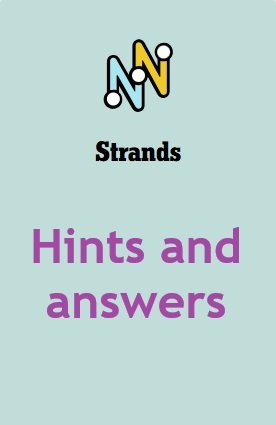NYT Strands hints, answers, cheat November 23, 2025 is DOTS, NERDS, RUNTS, STARBURST, WHATCHAMACALLIT, The Spangram today is CANDYAISLE, Strands: The Newest Word Puzzle Craze …

answers, cheat Forbes today

NYT Strands hints, answers, cheat November 23, 2025 is DOTS, NERDS, RUNTS, STARBURST, WHATCHAMACALLIT, The Spangram today is CANDYAISLE, Strands: The Newest Word Puzzle Craze …

NYT Strands hints, answers, cheat November 22, 2025 is BEARS, BULLDOGS, CRIMSON, LIONS, QUAKERS, TIGERS, The Spangram today is SPORTSTEAM, Strands: The Newest Word Puzzle …

NYT Strands hints, answers, cheat November 21, 2025 is ALIGN, DISRUPT, IDEATE, LIAISE, PIVOT, SCALE, The Spangram today is CORPORATESPEAK, Strands: The Newest Word Puzzle …

NYT Strands hints, answers, cheat November 20, 2025 is GOSSIP, HEARSAY, REPORT, RUMOR, SCUTTLEBUTT, The Spangram today is SPREADTHEWORD, Strands: The Newest Word Puzzle Craze …

Letter Boxed Answers Today November 20, 2025 is all you need to solve NYT Letter Boxed. Are you playing the New York Times Letter Boxed …

Letter Boxed Answers Today November 19, 2025 is all you need to solve NYT Letter Boxed. Are you playing the New York Times Letter Boxed …

Letter Boxed Answers Today November 18, 2025 is all you need to solve NYT Letter Boxed. Are you playing the New York Times Letter Boxed …

Letter Boxed Answers Today November 17, 2025 is all you need to solve NYT Letter Boxed. Are you playing the New York Times Letter Boxed …

Letter Boxed Answers Today November 16, 2025 is all you need to solve NYT Letter Boxed. Are you playing the New York Times Letter Boxed …

Letter Boxed Answers Today November 15, 2025 is all you need to solve NYT Letter Boxed. Are you playing the New York Times Letter Boxed …

Letter Boxed Answers Today November 14, 2025 is all you need to solve NYT Letter Boxed. Are you playing the New York Times Letter Boxed …

Letter Boxed Answers Today November 13, 2025 is all you need to solve NYT Letter Boxed. Are you playing the New York Times Letter Boxed …

Letter Boxed Answers Today November 12, 2025 is all you need to solve NYT Letter Boxed. Are you playing the New York Times Letter Boxed …

Letter Boxed Answers Today November 11, 2025 is all you need to solve NYT Letter Boxed. Are you playing the New York Times Letter Boxed …

Letter Boxed Answers Today November 10, 2025 is all you need to solve NYT Letter Boxed. Are you playing the New York Times Letter Boxed …

NYT Strands hints, answers, cheat November 19, 2025 is BUDDHA, IMAM, MONK, PRIEST, PROPHET, RABBI, The Spangram today is RELIGIOUSFIGURES, Strands: The Newest Word Puzzle …

NYT Strands hints, answers, cheat November 18, 2025 is CHAOTIC, JUMBLED, MUDDLED, SCRAMBLED, SHUFFLED, The Spangram today is OUTOFORDER, Strands: The Newest Word Puzzle Craze …

NYT Strands hints, answers, cheat November 17, 2025 is GUARD, GUIDE, HERDING, RESCUE, SERVICE, THERAPY, The Spangram today is WORKINGDOGS, Strands: The Newest Word Puzzle …

NYT Strands hints, answers, cheat November 16, 2025 is CELLOPHANE, FLATBREAD, FOIL, SCARF, SHAWL, STOLE, The Spangram today is THATSAWRAP, Strands: The Newest Word Puzzle …

NYT Strands hints, answers, cheat November 15, 2025 is BINOCULARS, GLASSES, GOGGLES, LENSES, SPECTACLES, The Spangram today is EYETOEYE, Strands: The Newest Word Puzzle Craze …